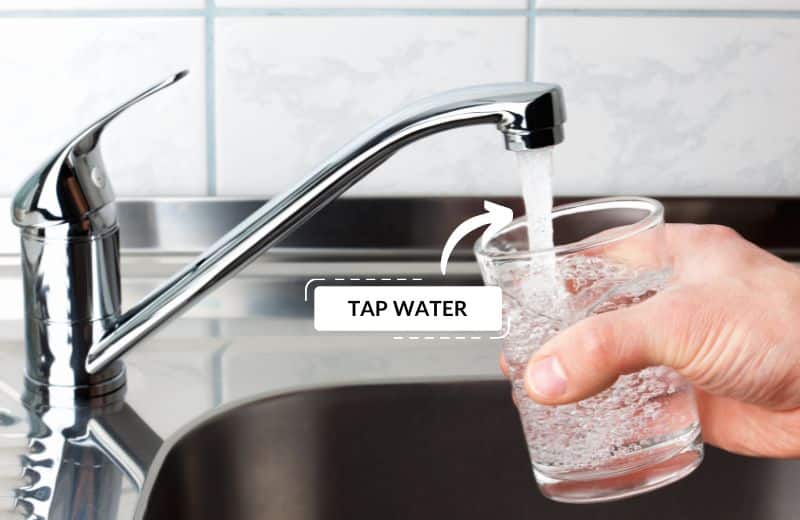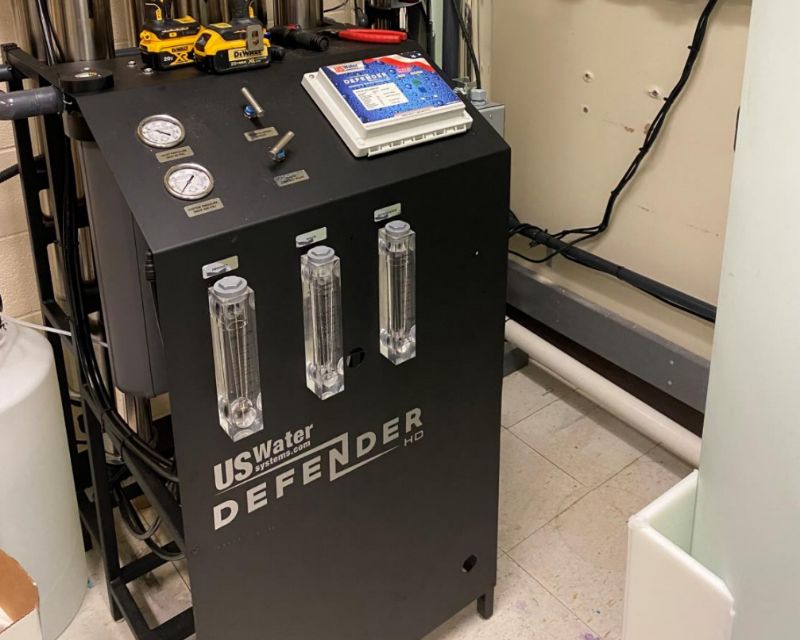Thallium is a chemical element and metal that’s sometimes found in drinking water supplies.
Here, we’ve shared all the important information about thallium in water, including how it gets there, how it could affect your health, and how to test for it.
📌 Key Takeaways:
- Thallium is a soft, malleable metal that occurs naturally in the environment.
- Some of the ways that thallium enters water supplies are through the erosion of rocks and soils, the burning of coal and other fossil fuels, and runoff from the use of thallium in pesticides.
- Thallium is highly toxic and may bioaccumulate in the body.
Table of Contents
- ❔ What Is Thallium In Water?
- 🚰 How Does Thallium Get Into Water?
- 🔎 How To Know If Your Water Contains Thallium
- 🚱 Is Thallium In Drinking Water Dangerous?
- 📉 Is Thallium In Tap Water Regulated?
- 🧪 How To Test For Thallium In Tap Water
- 👩🏽⚕️ What To Do If You’re Concerned About Thallium In Your Water
- ⚠️ Other Ways You Might Be Exposed To Thallium
- 📑 Final Word: Removing Thallium From Water
❔ What Is Thallium In Water?
Thallium is a naturally occurring heavy metal that’s found at low concentrations in the earth’s crust.
Thallium levels in the environment are naturally low, but human activity has increased the amount of thallium in certain regions, including in soils, crops, and water.
There are numerous uses of thallium today, including:
- As a catalyst in the chemical industry
- In the electronics industry
- In cement manufacturing
- In the manufacture of imitation precious jewels, optical lenses, and low-temperature thermometers
- In rat poison and insecticides (now banned)
- In certain medical procedures
Domestic use of thallium is banned due to the rising number of reported cases of unintentional poisoning.

🚰 How Does Thallium Get Into Water?
Both groundwater and surface water sources are at risk of thallium contamination.
There are a number of ways that thallium can get into a water source:
- Through erosion of rocks – When rocks containing thallium erode, thallium deposits may enter groundwater or surface water sources.
- Agricultural activity – Thallium was historically used in certain pesticides and rodenticides (this use was banned in the 1970s), and remnants of these products may enter a surface water source through runoff.
- Coal burning in power plants – The burning of coal in power plants may also cause thallium to enter rainwater (and eventually surface water) and groundwater sources.
- From waste disposal & emissions from manufacturing facilities – Emissions from factories dealing with thallium may increase airborne pollution that could contaminate water supplies due to natural settling and rainfall. Poor waste disposal practices could also cause thallium to enter surface water sources.
🔎 How To Know If Your Water Contains Thallium
Even high concentrations of thallium are tasteless and odorless – so much so that thallium was frequently used as a method of poisoning due to its lack of defining features.
So, if your drinking water contains any amount of thallium, no matter how large or small, you probably won’t know about it without further investigation.
Here are two ways to find out whether your water contains thallium:
Read Your Consumer Confidence Report
A Consumer Confidence Report, or Water Quality Report, is produced by all water utilities annually and contains information on the local water drinking water supply, including the contaminants detected and how they compare to maximum allowances.
So, if thallium was detected by your water utility, it should be listed in the Report, along with the concentration range and the average concentration present.
Search online to view the latest copy of your Consumer Confidence Report.

Test Your Water
You can also test your water to find out whether or not it contains thallium.
We recommend doing this if you have a private well (and the water isn’t treated before use) or you have a reason to be concerned about thallium in your drinking water.
We’ve shared more on testing your water for thallium later in this guide.
🚱 Is Thallium In Drinking Water Dangerous?
Thallium is dangerous in water for a couple of reasons: it’s invisible and impossible to detect without testing; and it’s one of the most harmful toxic substances and can be poisonous in large quantities.
There are a number of possible health effects that are associated with drinking thallium concentrations above the maximum allowance in water.
According to an EPA fact sheet, some of the short-term human health effects of thallium ingestion above the EPA Maximum Contaminant Level are:
- Damage to the nervous system
- Gastrointestinal irritation
- Diarrhea and vomiting
Long-term exposure to levels of thallium above the Maximum Contaminant Level could cause the following health effects:
- Changes in blood pressure
- Hair loss
- Liver and kidney damage
- Damage to the intestinal and testicular tissues
The first sign of thallium toxicity is typically gastrointestinal symptoms, which are then followed by neurological symptoms.
📉 Is Thallium In Tap Water Regulated?
There is known evidence of the adverse health effects of thallium exposure in water, so this contaminant is regulated by the Environmental Protection Agency under the Safe Drinking Water Act.
The EPA Maximum Contaminant Level for thallium is 2 PPB, or parts per billion. This is the maximum amount of thallium that is deemed to be safe and non-harmful to public health in drinking water.
However, organizations like the Environmental Working Group argue that the EPA’s MCL is too lenient, and they even trace amounts of thallium could have health implications. The EWG has set a non-enforceable Health Guideline of 0.1 PPB to protect against adverse effects in the internal organs.

🧪 How To Test For Thallium In Tap Water
Since thallium is too complex to detect with a DIY water test kit, you’ll need to purchase a dedicated laboratory test for this contaminant.
The average cost of a thallium laboratory test is $30-$75, depending on the complexity of testing and whether or not any other contaminants are tested.
Most lab tests have the following testing process:
- Test kit sent in post – A test kit will be mailed to you with the testing instructions and everything you need to take a sample.
- Water sample returned to lab – After taking your water sample, you’ll be instructed to ship it back to the lab.
- Test conducted at laboratory – The water test for thallium is then conducted at the laboratory.
- Test results delivered – You will receive your test report within 7-14 days.
The test data should outline the exact concentrations of thallium detected in your drinking water.
👩🏽⚕️ What To Do If You’re Concerned About Thallium In Your Water
If you’re concerned about the levels of thallium in your water, there are a few ways you can take action:
- If you own a private well, test your water and install a water treatment system to remove thallium from your drinking water supply if it’s detected.
- If you get your water from a municipal supplier and its concentration of thallium is within the legal limit, consider installing an at-home water filter to reduce thallium levels as much as possible.
- It’s unlikely that a test will detect levels of thallium above the EPA MCL in a public water supply, but if it does, contact your supplier with the test results and ask them how they plan to control contamination of your water going forward.

⚠️ Other Ways You Might Be Exposed To Thallium
Drinking thallium in your water is only one source of exposure to this heavy metal. Other sources of thallium exposure are:
- In certain foods – Many fruits and vegetables contain thallium, and these foods are typically our greatest source of thallium exposure.
- Thallium emissions in the air – If you live near ore processing sites, cement factories, coal-burning power plants, and smelting operations, you’re likely exposed to thallium in the air.
- Smoking – Cigarette smoking is another source of thallium exposure because thallium is found in cigarettes.
- Workplace exposure – If you work in a facility that uses thallium, you have a higher risk of exposure through inhalation and skin contact.
📑 Final Word: Removing Thallium From Water
Human exposure to thallium has been linked to hair loss, liver problems, high blood pressure, and other, more serious signs of thallium poisoning, so we understand if you’re keen to reduce even trace amounts of this contaminant in your water.
You can use the following at-home water treatment methods to reduce or remove thallium exposure from your water:
- Activated alumina filtration
- Reverse osmosis systems
- Ion exchange systems
These water treatment systems won’t only greatly reduce thallium – they’ll also improve your overall drinking water quality by removing other common contaminants. Just make sure to spend your money wisely on one of the best water filters with plenty of positive customer reviews.
